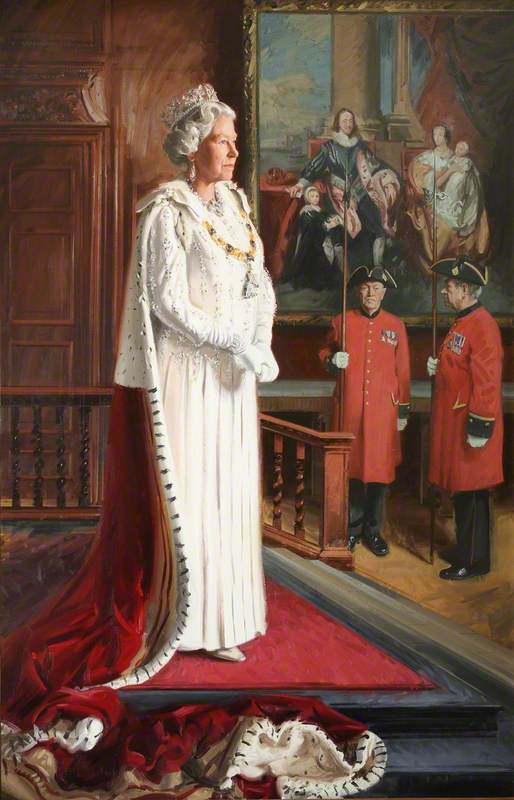In a strange twist of history, the image of Guy Fawkes returned to modern times in the past decade or so. A mask, first made for a comic book series, has taken on a new meaning, symbolising popular resistance to tyranny and dictatorship.
Demonstrators in Occupy movements around the world and the group Anonymous endowed his stylised features with a new meaning.
Closer to home, Bonfire Night is mostly about taking children to see municipal fireworks or just setting off a rockets and sparklers in your backyard.
Frederick Johnston's Bonfire Night at Chenderit School evokes the mystery and warmth of a fire on a cold November night, while Betty Brown's Boys at the Bonfire (Royal Ulster Academy) shows it as some fun for young lads.
A couple of decades ago children used to drag around a stuffed shirt and trousers, with a facemask on a droopy head, begging for 'a penny for the Guy'. It seemed a strange plea, as Guy (real name Guido) Fawkes was a regicide, who tried to blow up the King and Parliament in the infamous Gunpowder Plot of 1605.
Richard Ernst Eurich's surreal Men of Straw at Nottingham Castle Museum and Art Gallery relates to that almost voodoo-like tradition. Amongst a flurry of weird activities in the countryside, a black-clothed figure in a witches' hat is perched atop a glowing fire, about to be immolated.
Sober historians, however, tell us that Bonfire Night has nothing to do with ancient pagan rituals or the burning of effigies to quell evil, often held on the first of November. It dates purely from 1605 when King James I, shown in a painting (after an original by Daniel Mytens at St Mary's Guildhall, Coventry) declared 5th November a day of celebration after the fiendish plot was foiled.
The Discovery of the Gunpowder Plot and the Taking of Guy Fawkes in Henry Perronet Briggs' canvas of 1823 at Newcastle's Laing Art Gallery is a scene of struggle in a shadowy place. It is the moment when Fawkes was captured in a search of the Westminster cellars, after the First Lord Salisbury, the King's Chief Minister and spymaster was tipped off that something scary was afoot. Briggs's Fawkes, with a flamboyant black moustache, wears a wide-brimmed black hat and tries to draw a weapon just as he is being seized by armed guards.
The Discovery of the Gunpowder Plot and the Taking of Guy Fawkes
c.1823
Henry Perronet Briggs (1791/1793–1844) 
Fawkes is portrayed as a man of steely determination. His iron self-control, 'even evoked the admiration of King James', writes Antonia Fraser in her superb history of the plot. (That didn't prevent James from authorising torture to be used on Fawkes.)
Victorian artist Charles Gogin's Guy Fawkes is held by the York Museums Trust. His smaller painting revisits the theme in 1870. It's a grainy view of the skulking conspirator standing in a resigned fashion next to the barrels of gunpowder he had placed in the vaults below parliament. Guido Fawkes attended St Peter's school in York which to this day refuses to celebrate the burning of his effigy in loyalty to its old pupil.
Like all the plotters Fawkes met a gruesome death. Others, while not directly implicated and even those who tried to hold back the conspirators, were roped in by the crafty and ruthless Robert Cecil, Earl of Salisbury (County Hall, Hertford). He widened his net, stoking up anti-Catholic paranoia as he used the Gunpowder Plot to organise witch-hunts against priests and Catholic sympathisers.
The Royal painter Van Dyck made a superb portrait of Henry Percy, the 9th Earl of Northumberland, a version of which is held by the Royal College of Physicians. Percy, a great peer of the realm, was a Catholic sympathiser and a distant relative of one of the chief conspirators, Thomas Percy. The Earl's involvement in the plot remains controversial, but he was fined heavily and imprisoned in the Tower until 1621. Unlike lower-class suspects, he was never tortured or threatened with torture. He protested his innocence, saying that his lifestyle was 'given to private pleasures such as gardening and building'.
Henry Percy (1564–1632), 9th Earl of Northumberland
17th C
Anthony van Dyck (1599–1641) (after) 
Another remarkable painting is also from Van Dyck's studio. Sir Kenelm Digby, (National Maritime Museum) stands next to a ruffled sunflower, hand clasped to his heart. Digby was a successful diplomat, courtier, naval commander, and, like Henry Percy, a man of science. But his face is troubled – he remained a Catholic. He father Sir Everard, had been hung, drawn and quartered in January 1606 for his involvement in the Gunpowder Plot.
Sir Kenelm Digby (1603–1665)
1630s
Anthony van Dyck (1599–1641) (studio of) 
Remember, remember the 5th of November – but what do we remember? When you're watching the fireworks, these entangled stories of faith, persecution, opposition and power may not be in the foreground of your mind. But the conflicted significance of bonfire night still lies there, deep in the cultural psyche.
Corinna Lotz, writer





























